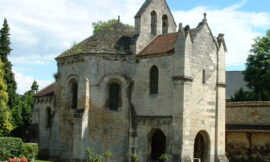Jedburgh Abbey, located in the town of Jedburgh in the Scottish Borders, is one of Scotland’s most magnificent and well-preserved medieval monastic sites. Founded in the 12th century, the abbey is a striking example of Romanesque architecture and a testament to the religious and historical significance of the region. Its history, architectural splendor, and enduring presence make it a focal point for visitors and historians alike.
Historical Background
Jedburgh Abbey was established around 1138 by King David I of Scotland as part of his widespread effort to reform and modernize the Scottish Church by introducing Augustinian canons. The abbey was strategically situated near the Anglo-Scottish border, making it an influential religious and political center. The canons at Jedburgh Abbey followed the rule of Saint Augustine, focusing on community life and service to the local population.
Throughout its history, the abbey witnessed numerous conflicts, particularly during the Wars of Scottish Independence and the Anglo-Scottish Border Wars. Its proximity to England meant that Jedburgh Abbey was frequently caught in the crossfire of these conflicts. Despite these turbulent times, the abbey managed to thrive as a religious institution until the Reformation in the 16th century, which led to the dissolution of monastic houses across Scotland.
Architectural Significance
Jedburgh Abbey is renowned for its impressive Romanesque and early Gothic architecture. The structure’s grandeur is evident in its soaring arches, intricate stone carvings, and detailed craftsmanship. The abbey church, with its stunning nave, transepts, and choir, showcases a blend of architectural styles that evolved over the centuries.
One of the most striking features of Jedburgh Abbey is its west front, which boasts a large, ornate doorway flanked by two towers. The interior of the abbey, particularly the nave, features a series of beautifully crafted arches and columns that create a sense of awe and reverence. The east end of the abbey, where the choir and presbytery are located, is equally impressive with its tall, graceful windows that once held intricate stained glass.
The cloister, situated to the south of the abbey church, was the center of monastic life. Although much of the cloister has not survived, the remaining fragments give a sense of the scale and layout of this important area. The chapter house, where the canons would meet to discuss abbey matters, and other monastic buildings also offer glimpses into the daily lives of the Augustinian canons who lived and worked there.
Cultural and Historical Impact
Jedburgh Abbey has played a significant role in the religious and cultural history of Scotland. It served as a center for learning, spiritual guidance, and community support throughout the medieval period. The abbey’s influence extended beyond its religious functions, impacting the social and economic life of the region.
The abbey’s association with key historical figures adds to its cultural importance. One notable visitor was Mary, Queen of Scots, who stayed in Jedburgh in 1566 while touring the Borders. Her stay at a nearby house, now known as Mary, Queen of Scots’ House, is a testament to the abbey’s significance during her reign.
Modern-Day Significance
Today, Jedburgh Abbey is managed by Historic Environment Scotland and is a major tourist attraction. Visitors come from around the world to explore the ruins, admire the architecture, and learn about its rich history. The abbey provides insight into the religious and political dynamics of medieval Scotland and serves as a poignant reminder of the region’s turbulent past.
Educational programs and events hosted at the abbey help to preserve and promote understanding of its historical importance. Efforts to maintain and conserve the site ensure that future generations can continue to appreciate its beauty and significance.
Conclusion
Jedburgh Abbey stands as a remarkable example of Scotland’s medieval heritage. Its architectural splendor, historical significance, and enduring legacy make it a vital part of the cultural landscape of the Scottish Borders. Whether one is drawn to its historical narratives, architectural beauty, or serene setting, Jedburgh Abbey offers a profound connection to Scotland’s past and an enduring symbol of its rich cultural history.



